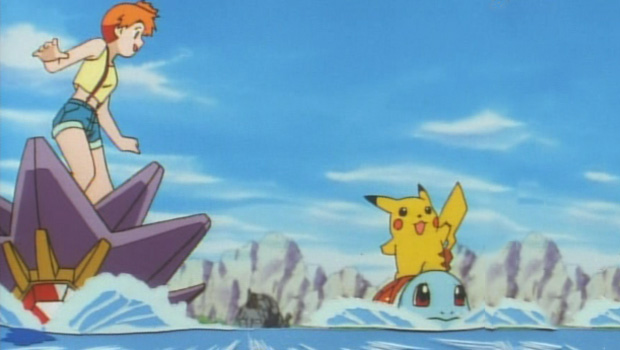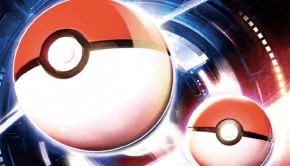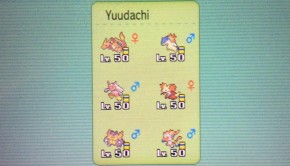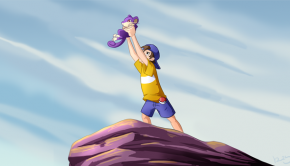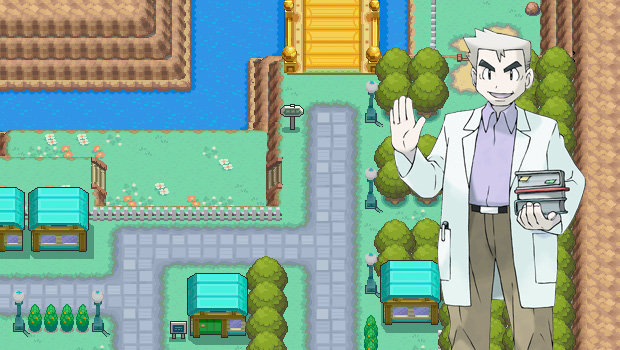When it Rains it Pours: A Beginner’s Guide to Rain
The VGC 2012 metagame is one that has a wide variety of available strategies, possibly more than in any previous year. Teams that control the weather are very popular, and among the four different types of weather Rain is by far the most popular due to the large number of Pokémon that can benefit in some way from Rain. Players new to VGC often start off with weather teams since the concept is easy to grasp and helps them to get their feet wet. This doesn’t mean that weather isn’t effective at high level play, though!
The basis for any Rain team is Politoed, whose Dream World ability Drizzle can cause an endless Rain to begin pouring onto the field and can only be stopped by another weather starting or from the abilities Cloud Nine or Air Lock.
Drizzle
![]()
Politoed is the basis of every 2012 Rain team for the simple reason that it is the only legal Pokémon with the ability Drizzle. It doesn’t have particularly strong offenses, although some people like to give it a Water Gem to help with that. It is usually utilized on one extreme or the other of the Speed spectrum — some players go for a more offensive Politoed with Choice Scarf, 252 Special Attack and a Modest nature, while others go for a slower 0 speed IV, speed reducing nature defensively oriented Politoed designed to take hits and be able to switch in and out to restart Rain multiple times in a match if needed. For the slower Politoeds, items like Sitrus Berry or Wacan Berry are popular. Politoed’s offensive move selection isn’t that great, and you’ll usually see it limited to moves like Scald, Surf, Ice Beam, and Hidden Power Electric or Grass. Politoed also learns good support moves such as Encore, Hypnosis, Helping Hand and Perish Song.
Swift Swim
Swift Swim is the ability that partners with Rain to make it the powerhouse that it is. It doubles a Pokémon’s Speed while Rain is active, allowing it to strike first against almost any other foe. Ludicolo and Kingdra are the premier users of Swift Swim but serve different purposes despite sharing the same great ability.
Ludicolo is the bane of any rain team as its double resistance to water combined with STAB Giga Drain make it incredibly difficult to faint for a lot of émon. Ludicolo prefers items such as Life Orb, Absorb Bulb, or Grass Gem. Its offensive capabilities consist of moves like Scald, Surf, Giga Drain, Ice Beam, and Fake Out. It also learns Leech Seed and Teeter Dance.
Kingdra is slightly more fragile than Ludicolo and has no meaningful methods of health recovery like Ludicolo does. However, what Kingdra does possess is dual Water/Dragon STAB attacks, as well as an array of incredibly disruptive support moves. Kingdra’s primary offensive options consist of Muddy Water, Scald, Dragon Pulse, Draco Meteor, Surf, and Ice Beam. Kingdra also learns Quash and Disable, two moves it can very effectively utilize thanks to its monstrously high speed in Rain.
Rain Dish
![]()
![]()
Rain Dish is a less commonly featured ability on Rain teams. Every turn that Rain is active, the Pokémon with Rain Dish will recover 1/16th of its help.
Ludicolo is much more commonly is seen with Swift Swim, but Rain Dish + Leftovers + Giga Drain and Leech Seed combined with a defensive EV spread can allow it to survive for an annoyingly long time and constantly pressure the opponent’s Pokémon. Tentacruel on the other hand doesn’t have any HP recovery outside of Rain Dish, Leftovers or Black Sludge, but its defensive stats are better and it also resists Fighting-type moves which not many water Pokémon can do. Tentacruel’s STAB Sludge Bomb also allows it to take out enemy Grass Pokemon with ease, which can otherwise annoy Rain teams.
Storm Drain, Water Absorb and Dry Skin
![]()
![]()
![]()
![]()
![]()
Next up are a bunch of Pokémon that have abilities that provide immunity to water type attacks in addition to other benefits.
Gastrodon and Cradily both have the ability Storm Drain which not only provides immunity to water attacks but actively draws them towards the Pokémon with Storm Drain and provides +1 Special Attack every time one is drawn in.
Gastrodon is the more popular of the two as it is immune to electric attacks and has all-around better defensive typing. Gastrodon’s offensive move selection is quite varied, although you’ll usually see it utilizing moves such as Muddy Water, Scald, Ice Beam, and Earth Power. It also learns Recover which can be tremendously helpful if your opponent is forced to use Protect due to the threat posed by Gastrodon’s partner. Gastrodon commonly utilizes Rindo Berry to reduce damage from its 4x grass weakness, although more offensive players might choose to use a Water Gem or Earth Gem instead.
Cradily is both similar and different to Gastrodon. It also has Storm Drain, but is weak to ice and fighting moves. However, it gets STAB Giga Drain which allows it to fight back against things like Rotom-W far better than Gastrodon can. Cradily’s rock type allows it to gain boosted Special Defense when Sandstorm is active. Because of this you’re likely to see Cradily as a partner to Tyranitar. Cradily frequently uses Chople Berry in order to endure hits from things like Hitmontop that would otherwise wreak havoc on poor Cradily.
Vaporeon gets Water Absorb, which doesn’t draw in water attacks or raise its Special Attack, but does heal it for 25% every time an attack is absorbed. Combined with an ally or two that knows Surf, this is quite powerful. Vaporeon’s offensive move selection is rather limited, and similar to Politoed will probably be limited to a water attack like Scald or Surf, Ice Beam, and maybe Hidden Power. Item wise, a Water Gem or a Wacan or Rindo Berry is most commonly used.
Jellicent is another Pokémon with Water Absorb. It possesses the unique dual Ghost/Water typing that renders it immune to the ever so common Fake Out and makes it an ideal user of Trick Room. Water Absorb allows its ally to use Surf to both damage its opponents and heal Jellicent. Jellicent also learns Water Spout, which allows it to inflict massive damage despite not having an amazing Special Attack stat. Since Jellicent is immune to Fake Out, another route that some people prefer is equipping it with a Choice Scarf, while those utilizing a slower Trick Room variant usually prefer a Water Gem or a Wacan Berry. Paired with a Surf partner, Jellicent can stay healthy and fire off powerful Water Spouts all day long. Other toys in Jellicent’s bag of tricks include Shadow Ball, Energy Ball and Will-O-Wisp.
Toxicroak combines the best of two worlds. Dry Skin provides passive health regeneration in Rain just as strong as Rain Dish and also provides the same water immunity and healing granted by Water Absorb. Toxicroak’s main attacks consist of Fake Out, Drain Punch, Sucker Punch, and occasionally Rock Slide. He also learns Taunt. Toxicroak is commonly seen with a Focus Sash, since with his plethora of healing methods being lowered to 1HP isn’t necessarily the end for him.
Pokémon with Fire Weaknesses
![]()
![]()
![]()
Metagross, Scizor and Ferrothorn all have one thing in common: their Steel typing makes them weak to Fire. They are all powerful in their own right, each serving a slightly different role, and they all feel right at home on a Rain team since their most prominent weakness is effectively negated thanks to Rain halving damage dealt by Fire moves.
Metagross has been a consistently strong Pokemon in VGC throughout the years for a variety of reasons. This year, its immunity to the incredibly powerful ability Intimidate combined with great defensive stats, resistance to dragon moves, and great STAB moves like Meteor Mash and Zen Headbutt has made it one of the most commonly used Pokémon out there. Metagross has an incredibly diverse movepool, consisting of the previously mentioned Meteor Mash and Zen Headbutt, as well as Iron Head, Earthquake, Ice Punch, Bullet Punch, Thunderpunch, and Explosion. Metagross learns Trick as well, which when combined with a Choice Scarf or Choice Band allows him to severely cripple many enemy Pokemon.
Scizor is the king of priority in 2012 thanks to Technician and its STAB Bullet Punch. Scizor also has Bug Bite, which gets a boost first from Technician and again if the enemy Pokémon has a Berry. Scizor’s offensive options include the previously mentioned Bullet Punch and Bug Bite, as well as Aerial Ace, Acrobatics, and Superpower. Scizor also learns Swords Dance, Tailwind, and Roost, which allow it to take advantage of turns where your opponent uses Protect.
Ferrothorn is perhaps most at home on a Rain team; its grass typing allows it to resist Water attacks and deal with opposing Water Pokémon that its teammates might have a hard time with. Ferrothorn’s attacks are usually limited to Power Whip and either Gyro Ball or Iron Head. It also learns Leech Seed and Substitute. Due to its abysmally low speed, it is an amazing Trick Room counter as well.
Electric Pokemon
![]()
![]()
![]()
Due to the fact that most Water Pokemon don’t learn moves that can effectively defeat other water Pokémon, every Rain team needs ways to deal with that. Ludicolo is one option, but using an electric Pokémon is also a common way to approach this problem.
Rotom-W is an absolute monster in rain — it gets STAB Hydro Pump, as well as STAB Thunder or Thunderbolt. It also resists incoming water and ice attacks, takes neutral damage from Electric, and is immune to Ground. That being said, Rotom-W’s offensive move choices outside of its obvious STAB moves are limited, and usually Hidden Power Grass is the only other option. Rotom-W learns Will-O-Wisp as well as Trick, which when used in conjunction with Choice Specs or Choice Scarf allows Rotom-W to lock enemy Pokemon into one move or utilize the choice item for its own benefit depending on which would be more beneficial.
Thundurus’ claim to fame is Prankster. It is generally limited to Thunder or Thunderbolt + Hidden Power for its attacks, but its real power is +1 priority Thunder Wave, Taunt, Substitute and Swagger.
Zapdos, when discussing Rain teams, is probably the least used of these three Electric types. This is due to the fact that a major part of Zapdos’ offensive kit is Heat Wave, which is neutered by rain. However, Zapdos is bulkier than the other two Electric types mentioned, and also gets Tailwind. Zapdos’ offensive options are Thunderbolt, Heat Wave, and Hidden Power Flying or Ice. Besides Tailwind, Zapdos also gets Roost and Thunder Wave.
Conclusion
This is just a small sampling of Pokémon that work well in conjunction with the Rain weather effect. Just how far to commit to weather is something that a lot of players deal with. Some teams invest only one or two slots of their team on weather, perhaps choosing just to have a weather user on their team in order to disrupt whichever weather type is most inconvenient to their own strategy while focusing primarily on a strategy that functions independently of the weather. Others may choose to rely more on it, which is a double-edged sword. The more your team relies on weather being active, the more it will be negatively impacted if you cannot maintain control of the weather. Weather does not have to be used alone, either; Trick Room, Reflect/Light Screen, Tailwind, and a number of other strategies can work in conjunction with weather, and doing so allows you to not put all your eggs in one basket and increase your chances of victory.

